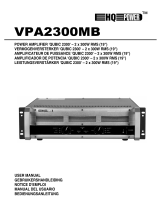
English 7
■ Installation procedure
Since there are large variety of settings and
connections possible according to applications, read
the instruction manual well to select the proper
setting and connection.
1. Remove the ignition key and disconnect the
negative - terminal of the battery to prevent short
circuits.
2. Set the unit according to the intended usage.
3. Connect the input and output wires of the units.
4. Connect the speaker wires.
5. Connect the power wire, power control wire and
grounding wire following this order.
6. Install the unit in the car.
7. Connect the negative - terminal of the battery.
2 WARNING
To prevent fire caused by a short in the wiring,
connect a fusible link or breaker nearby the battery’s
positive terminal.
2 CAUTION
• If sound is not output normally, immediately turn
power off and check connections.
• Be sure to turn the power off before changing the
setting of any switch.
• If the fuse blows, check wires for shorts, then replace
the fuse with one of the same rating.
• Check that no unconnected wires or connectors are
touching the car body. Do not remove caps from
unconnected wires or connectors to prevent short
circuits.
• Connect the speaker wires to appropriate speaker
connectors separately. Sharing the negative wire of
the speaker or grounding speaker wires to the metal
body of the car can cause this unit to fail.
• After installation, check that the brake lamps,
winkers, and wipers work properly.
■ Wiring
• Take the battery wire for this unit directly from the
battery. If it's connected to the vehicle’s wiring
harness, it can cause blown fuses etc.
• If a buzzing noise is heard from the speakers when
the engine is running, connect a line noise filter
(optional) to each of the battery wire.
• Do not allow the wire to directly contact the edge of
the iron plate by using Grommets.
• Connect the ground wire to a metal part of the car
chassis that acts as an electrical ground passing
electricity to the battery‘s negative - terminal.
Do not turn the power on if the ground wire is not
connected.
• Be sure to install a protective fuse in the power
cord near the battery. The protective fuse should
be the same capacity as the unit’s fuse capacity or
somewhat larger.
• For the power cord and ground, use a vehicle type
(fireproof) power wring cord with a current capacity
greater than the unit’s fuse capacity. (Use a power
wiring cord with a diameter of 5 mm² (AWG 10) or
greater.)
• When more than one power amplifier are going
to be used, use a power supply wiring wire and
protective fuse of greater current-handling capacity
than the total maximum current drawn by each
amplifier.
■ Speaker selection
• The rated input power of the speakers that are
going to be connected should be greater than the
maximum output power (in Watts) of the amplifier.
Use of speakers having input power ratings that
are less than the output power of the amplifier will
cause smoke to be emitted as well as damage.
• The impedance of the speakers that are going
to be connected should be 2Ω or greater (for
stereo connections), or 4Ω or greater (for bridged
connections). When more than one set of speakers
are going to be used, calculate the combined
impedance of the speakers and then connect
suitable speakers to the amplifier.
2 Ω
8 Ω
4Ω
4Ω 4Ω
4Ω
Combined impedance













